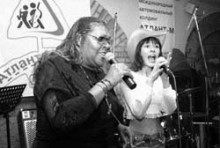Jazz is a kind of arts that is born before the audience’s very eyes, or rather ears. Can one learn to create jazz improvisations or is it an exceptional gift of nature? Today the whole world is learning to play jazz: for over twenty years most American, European, and part of Russian musical higher education institutions have had jazz faculties. Jazz preserves and develops all the styles that were formed as a result of its century-long history: from the early traditional jazz and Dixieland to the most complicated contemporary free, modal, fusion, and the subsequent petty trends. Jazz has outgrown its Afro-American roots, combining the attainments of the most complicated philharmonic avant-garde with some vestiges of its initial style, mostly in terms of rhythm. To completely understand this complex art, one has to not only master improvisation, but also possess a profound grounding in the field of music history and theory. This includes classic and jazz harmony, polyphony, analysis of musical forms, folklore and classical music, as well as an ability to master one’s instrument, be it voice, a saxophone, or piano, no worse than academic musicians. This conclusion suggests itself after a contact with renowned American and European jazz musicians who have been on tour in Kyiv for the last few years.
In Ukraine children are also taught jazz. There are jazz departments at some musical schools and colleges, though not at conservatories: our provincial caution and conservatism are too strong. Moreover, there is a lack of teachers: their work is paid more than modestly, and most of those taking it are either altruists who cannot live without their pupils, or unsuccessful musicians (mind that playing a musical instrument and teaching others to do it is not the same thing). The meagerness of state financing for this sphere of musical education is blatant. Classical specialties also suffer from the lack of financing, affecting all branches of musical education from children’s musical schools to colleges to conservatories. They lack instruments and scores (recently the last music bookstore in Kyiv closed for the lack of goods: musical publishing houses are idle). Many children’s musical schools have no premises. For instance, the Kyiv Children’s Musical School No. 29 that is celebrating its thirtieth anniversary or the world famous Gliere Musical College have to lease premises wherever they can. To teach jazz, which envisions playing electronic instruments and singing with a microphone, requires equipment even more complicated and sometimes expensive compared to acoustical instruments.
There are philanthropists in Kyiv supporting the jazz movement, for example, the renowned owner of a restaurant chain Eric Aigner, whose Club 44 is a regular jazz nursery for Ukraine. This club has hosted concerts of true stars of the world jazz: saxophonist Ernie Watts, Joe Zawinul (keyboard) and his Syndicate band, guitarists Eduardo Niebla and John McLaughlin, bass guitarists Dean Brown and Victor Baily, percussionist Billy Cobham, and multi-instrumentalists Muthspiel brothers. Young performers also often debut in his club. Recently the musical movement in Ukraine has received another supporter who announced a whole program in this sphere: on the initiative and with the support of the Atlant-M automobile concern, The First Children’s Jazz Festival CD was presented recently at the 44 Club. The three-day festival was hosted by this same club. Its participants were best young jazzmen, pupils of the Kyiv children’s musical schools. The children enjoyed their modest money honoraria, excellent treatment, presents, and unforgettable festive atmosphere. The company’s financing for the festival, as well as releasing 1000 copies of the CD recorded in its course, is a rare example in our contemporary life. The disc has a certain interest: children are singing and playing, accompanied by the Skhid [East] stage band, one of Ukraine’s most professional jazz instrumental groups. The young jazz artists’ performance attracts one with its spontaneity and naivete. It would be premature to speak about contemporary jazz styles; the children still remain in the “no-later-than- swing” period; some of their improvisations seemed well prepared in advance; but still it is not bad for a start. Among participants there were mature musicians, like winner of many international festivals 13-old singer Yuliya Holovan. In addition to children, adult artistes also took part in concerts: the Yuliya Roma (vocal) and Natalia Lebedeva (keyboard) duet, the Beauty Band girls’ vocal quintet, and foreign guests: San-Francisco-based singer Denise Perrier accompanied by keyboard player Andrei Kondakov from St. Petersburg. The festival’s host, co-producer (together with Yuliya Kazharska representing the Atlant-M company), and second father for its thirty participants aged from 6 to 15 was popular radio commentator Oleksiy Kohan.
In the civilized West every company, which does not belong to mass culture — be it a symphonic or jazz orchestra, folk group, or theater troupe — has a respectable sponsor. There, philanthropy is a matter of tradition and almost a must. For instance, the Munich Symphony Orchestra always advertises its sponsor, the Audi concern, in every playbill. Here we still have a way to go. However, the first steps are pleasing. The application period has been announced for the next festival, scheduled to be held in a year. Due to the organizers’ the festival and CD promise to become traditional and rise to the international level.







